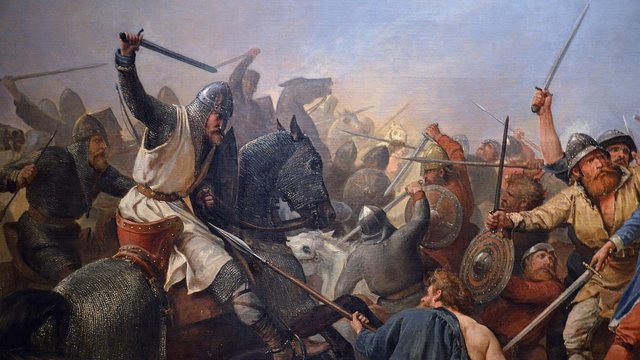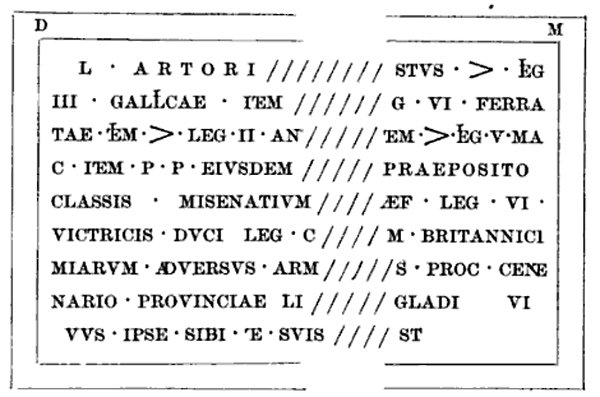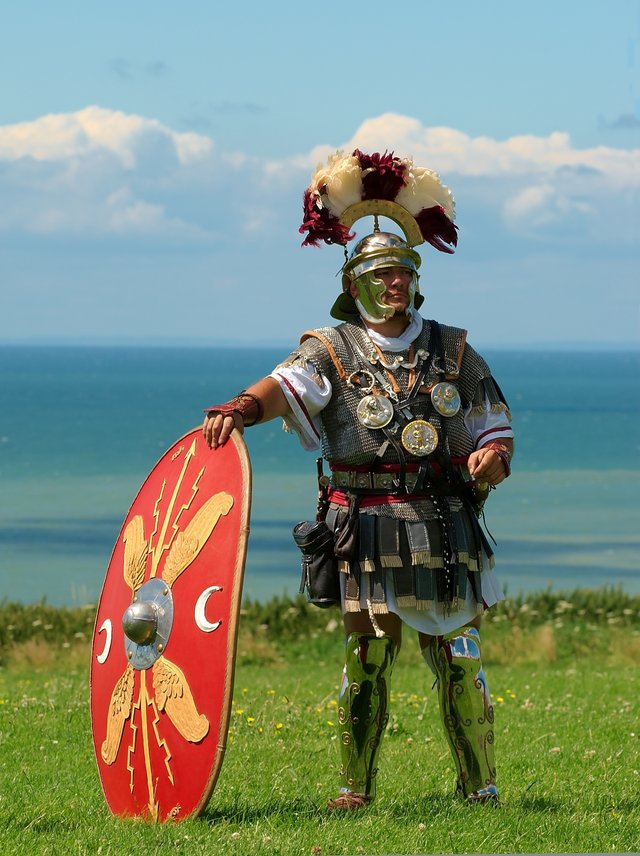King Arthur - Who was he ?
There are probably a few people in the world that have not heard the story of the legendary King Arthur of Camelot, his wife Guinevere, the wizard Merlin and his knights of the roundtable. This story has been told over centuries and is part of British folklore. The tale of King Arthur is the medieval equivalent of Greek tales and legends like ancient heroes fighting against the greater evil. During modern times the subject was taken to the silver screen and TV screens and there were a lot of movies filmed with the theme about King Arthur some were bad some were good but this is a topic for another post.

Like most tales of the past from human history grew into legends and folktales a lot of these tales have a little bit of truth behind them. Some of these heroes from Greek, British or other mythologies were probably ordinary men or women completing some deed making them eternal figures to us. Their stories were told over generations and somethings and details were added to touch up or freshen up the story.
For sure this is the case with King Arthur we know that some things were added over the centuries by writers to give the tale more importance or to ideologies the figure of the good king helping his people fighting of evil. There are a few theories on the subject of King Arthurs origin and if some of the deeds he has done were true.

More or less everyone knows about the legend of King Arthur and I will not recap the story if you want to read about the legend best is to start here. I would try to explain a possible origin of King Arthur through a quick historical occurrence of the legend and some archeological evidence found here in Croatia. King Arthur was the leader of the British defense against the Saxon invaders during the late 5th beginning of the 6th century. Most of the written evidence is heavily debated by scholars today as it was written and rewritten over the centuries and the original scripts do not match historical facts. One of these written sources it the text Historia Brittonum, this text was written by a 9th-century monk from Wales by the name of Nennius. As you can see the Historia Brittonum was written almost 400 years after the battles of Arthur. The second text giving us information about the King and his battles against the Saxons is the Annales Cambriae which were written during the 12th century. Many scholars believe that the Annales Cambriae where copied from the 10th-century original, again written almost 600 years after King Arthurs battles. Among the not so well known texts mentioning Arthur are the writings of Gildas a 6th-century British monk describing post-Roman Britain before and during the Saxon invasion.
There is a large number of theories about Arthurs origin, questions about who he was and where he came from. One of these theories connects my homeland Croatia with the Legend of Arthur. To be precise the small settlement of Podstrana just behind modern Split was probably the last resting place of a man known to us as LUCIUS ARTORIUS CASTUS, a retired Roman military commander. In Podstrana, two Roman inscriptions chiseled in stone were found reused as building material for the 19th-century church of St. Marin. The first larger inscription was part of a stone sarcophagus, the second was a stone commemorative plaque smaller in size.
But who was Lucius Atorius Castus? thanks to his middle name or in ancient Rome his nomen gentilicium ARTORIUS which is his family name, we can trace most of his relatives including him. So Lucius Artorius Castus was probably of Etruscan or Messapic descent which means that he was a native of Italy and his forefathers gained Roman citizenship early on. This is an important fact as it gave him the possibility to become a career soldier an easily move through the ranks. The discovered pieces of the sarcophagus inscription tell us a lot about Artorius life and military career.
Sarcophagus inscription
The first inscription gives us a lot of information just by the way it was crafted and the location of it. Here is what we know so far, it was found in Podstrana, during Roman rule called Pitunium in the province Liburnia. The inscription was discovered in 1850 and it tells us about Lucius Artorius Castus and his cursus honorum or the course of his military career. From this archaeologist could reconstructed the period he lived in around the mid 2nd to early 3rd century.

Text from the inscription is telling us about the cursus honorum of Lucius Artorious, the dots between the Latin epigraphic text represent the parts that are damaged.
D ……………………………………………………………..M
L ARTORI[…………………………………..]STVS 7 LEG
III GALLICAE ITEM […………………..]G VI FERRA
TAE ITEM 7 LEG II ADI[………….]TEM 7 LEG V M
C ITEM P P EIVSDEM [……………..] PRAEPOSITO
CLASSIS MISENATIVM […………….]AEFF LEG VI
VICTRICIS DVCI LEGG [………….]M BRITANICI
MIARVM ADVERSVS ARM[….]S PROC CENTE
NARIO PROVINCIAE LI[…………….…] GLADI VI
VVS IPSE SIBI ET SVIS […………………]ST[……….]
Source
Latin epigraphy is tough to decipher and the Latin transcription would go probably something like this. There are a few transcriptions made by historians so this is not the only one.
D(is) M(anibus)
L(ucius) Artori[us Ca]stus centurioni leg(ionis)
III Gallicae item [centurioni le]g(ionis) VI Ferra-
-tae item centurioni leg(ionis) II Adi[ut(ricis) (P{iae} F{idelis}?) i]tem centurioni leg(ionis) V M[a]-
-c(edonicae) item p(rimo) p(ilo) eiusdem [leg(ionis)] praeposito
classis Misenatium [pr]aef{f}(ecto) leg(ionis) VI
Victricis duci legg(ionum) [triu]m Britan(n)ici-
–{an}arum adversus Arm[enio]s* proc(uratori) cente-
-nario provinciae Li[burniae iure] gladi(i) vi-
-vus ipse sibi et suis [… ex te]st[amento]
Source
The same goes for the translation to English or other languages there are many versions by different authors.
To the divine shades, Lucius Artorius Castus, centurion of the Third Legion Gallica, also centurion of the Sixth Legion Ferrata, also centurion of the Second Legion Adiutrix, also centurion of the Fifth Legion Macedonica, also chief centurion of the same legion, in charge of (Praepositus) the Misenum fleet, prefect* of the Sixth Legion Victrix, commander of two** British legions against the Armenians, centenary procurator of Liburnia with the power of the sword. He himself (set this up) for himself and his family in his lifetime.
Source.
The translation of the inscription tells us a lot about Lucius Artorius Castus, which rank he held, in which legion, unit, and where he was stationed. One crucial thing is not in the inscriptions and that is the date but as Roman history and military campaigns are well documented the reconstruction of a timeline is no big problem.
Meomrial plaque inscription
The plaque was found not far away from the first one and it was also discovered in pieces. Although it is smaller in size it also tells us about his military career.
L • ARTORIVS
CASTVS • P • P
LEG • V MAC • PR
AEFEC[.]VS • LE[.]
VI • VICTRIC •
Source
L(ucius) Artorius
Castus, p(rimus) p(ilus)
leg(ionis) V Mac[(edonicae)] pr-
-aefec(t)us leg(ionis)
VI Victric(is)
Source.
Lucius Artorius Castus, Primus Pilus of the legion V Macedonica, Prefect of the Legion VI Victrix
Source.
Military path
From the inscription, we know that Artorious climbed the ranks from legionary to centurion in the Gallic III Legion (legio III Gallica) stationed in Syria during the 2nd and 3rd century. A centurion was a professional officer and commanded a centuria a military unit composed of 100 men, 80 soldiers, and 20 servants. The Centurion was appointed among men from the centuria normally more experienced soldiers were chosen for this post with 15-20 years of service on there back. Further on he served as a centurion in the VI Ironclad Legion (legio VI Ferrata) stationed in Judea and the Rescuer II Legion (legio II Adiutrix) stationed in Aquincum (Budapest) during the 2nd and 3rd century AD. He served also in the V Macedonian Legion (legio V Macedonica) stationed in Dacia (Romania) the legion was stationed here also during the 2nd and 3rd century AD. The legion saw a lot of action and fought against barbaric tribes like the Quadi, Marcomanni, and Samaritans. Artorius was promoted to the rank of primus pilus or first spear, the senior officer in charge of the first Cohort and 6th in command in the entire legion. This the highest rank a simple soldier could rise. The primus pilus was chosen among the centurions and usually more experienced men with a long service history were appointed to this rank.

After his service in the Roman legions, Lucius Artorius Castus was put in charge of the Misenum fleet based either in the bay of Naples or Ravena. The Misenum fleet did not see much combat the important fact about fleet command is that we know for sure that Artorius was from the equestrian class. The navy was seen inferior to the Roman infantry and was made out of noncitizens, freed slaves and so on. Due to the navies bad reputation, the patrician nobility did not take commanding posts therefor for commands in the navy, high ranking officers from the equestrian class were chosen like our Artorius.
After his temporary post in the Misenum fleet, Artorius was promoted to Praefectus legionis or camp-prefect in the Victorious VI Legion (legio VI Victrix) stationed in Britain. The position of praefectus legionis is similar to praefectus castrorum usually, soldiers with a long service record between 50-60 years of age were chosen for this position. The camp-prefect was the 3rd in command in the legion, his responsibilities were the day to day tasks that made the legion camp work smoothly. He was taking care of equipment, building, inventory and so on but he could command the legion if senior officers were absent. This was the highest rank an equestrian class soldier could rise in the legion, usually given to a primus pilus before the end of his military service.
During his time in Britain Artorius was given a temporary command of troops drawn from the legions into an expeditionary force called Britanniciniae. We know this from one of his titles like dux legionum this title was given to camp prefects acting above their rank in some cases. The Britanniciniae expeditions were removed on few occasions from their legion camp during the 1st, 2nd, and 3rd century AD. Artorius led these forces against the Sarmatians probably during the 2nd century.
This is all we know of Lucius Artorius Castus he ended his journey in the Roman province Liburnia as a procurator in charge of finances for a province. This is a high civilian position for a man from the lower classes. Finishing his military career he was given a pension and probably some land in the province of Dalmatia were he settled after his last station in Britain.
These are all facts we know of Lucius Artorius Castus life if he was the foundation for the legend about King Arthus is up for further debate. But one can see that there are some touching points between the two like his name and he fought in Britain. It could be possible that the life of a Roman career soldier was the basis for the story of King Arthur.
I hope you enjoyed my post on the origin of Arthur if you have any questions please let me know in the comments below.
Good luck to all of you until next time @zija2022.
Bibliography
- https://en.wikipedia.org/wiki/King_Arthur
- https://www.britannica.com/topic/King-Arthur
- http://christophergwinn.com/arthuriana/lac-sourcebook/
- Kurilić A.M., 2012., Lucius Artorius Castus and the King Arthur legend, Proceedings of the International Scholarly Conference from 30th of March to 2th of April 2012, Podstrana.
You received a 60.0% upvote since you are a member of geopolis and wrote in the category of "archaeology".
To read more about us and what we do, click here.
https://steemit.com/geopolis/@geopolis/geopolis-the-community-for-global-sciences-update-4
I thought your article was informative and well written. I enjoyed reading your analysis and speculations.
thank you I am glad you liked it :D
As a kid, I was kinda obsessed with this legend. I watched every movie about it, read many many books, my favorite was “le mort d’arthur” by Thomas Mallory. The historical background is interesting, but I still prefer the legend
I like this one it has some historical background and there was even a congress in 2012 where not just Croatian historians took part but also some major players from Britain, France, and Italy. Some of the brits helped in the movie King Arthur 2004. these inscriptions were the inspiration for the story.
Well, the movie is about few-day skirmish action and a battle at the end, also set in 5th century, two hundred years after real Artorius. So I prefer Excalibur (1981), hardly that any arthurian movie will ever be better
I agree with you :D
More fantasy than reality but man no doubt this guy is a great example of how a single individual can change the course of a countries history!
FYI this has nothing to do with the Balkans so the "steemitbalkan" tag might get you in trouble :)
Thanks for the comment would be even better if you read any of the post @aykutpurde
And FYI my post is an archaeological analysis of Roman inscriptions written in stone which were found in Podstrana, Dalmatia which is a region in Croatia as far as I know the country of Croatia is in the Balkans ;) the western part of it to be exact. I think I will be ok with the @steemitbalkan people no worries :D
The thought and time you put in your posts are starting to be amazing. I forget sometimes that I am reading your texts on a platform, they are book material. A Monty Python image was a cute touch :)
Thank you @zen-art Nooo books :D Monthy Phytons King Arthur and his knights is a must be when covering the legend :)
Hi @zija2022! You have received 0.1 SBD tip from @tattoodjay!
@tattoodjay wrote lately about: Feel free to follow @tattoodjay if you like it :)
Protip: if you want to send tips and upvotes from @tipU you need to make a deposit first.
As a youngster i was fascinated by King Arthur and when I was told by one of our Colleagues in Croatia about this church and its history and ties with King Arthur I had to visit it, I was lucky enough to have a work trip to Split to pick up vehicles and I managed to get the time to go and visit this place which I was fascinated by, this post both refreshed my memory of what I saw there but gave me a lot of information which was new to me so thanks for sharing
tip!
@tattoojay wow you have been to Podstrana, it is a small church by the side of the road who would have guessed :D thanks for the support.
I was lucky enough to have a friend mention it and had to go there
Really cool, interesting fact I don't know if you knew it this story about Lucius Artorius Castus was the basis for the 2004 King Arthur movie :)
No I hadn’t heard of that movie will have to check it out
I have heard of King Arthur. But was not knowing anything in this detail. Thanks for the article.
I have a small concern regarding the license of images used. Maybe you want to check if these have no copyright issues. You should mention the license and attribute it properly according to steemSTEM copyright guidelines for the articles.
I took care of it :D
Yes your images are okay now. But you need to mention the license info and attribution I guess. Like if a license is CC version 4, you should mention those details.
I loved King Arthur stories. Well done.
thank you :)
Odličan post...uloženo je puno truda i rada...iskreno, po meni bi trebao da piše iznos minimum $50.99.
Hahaha e baš ti hvala @mixology, jesam trudio sam se :) a da nije ovih dobrih ljudi iz SteemSTEM-a pisalo bi $ 2.99. Nemam puno folower-a a koliko sam skuzio na Steemit-u ne prolaze kvalitetni postovi neko kao kod nas na balkanu ko zna više ljudi i ima više šuške :D
Bitno da je neko prepoznao kvalitet u tvom postu,a svi vidimo kako stvari funkcionišu na Steemit-u. Drago mi je da bar mi balkanci pravimo neku razliku. A reci mi kada se uglavnom koristi tag SteemSTEM, za koje tematike je karakterističan, koje teme traže?
@mixology posla sam ti u discord :)
Super, hvala ti. Moram sad da idem pa cu da procitam kad se vratim. :)